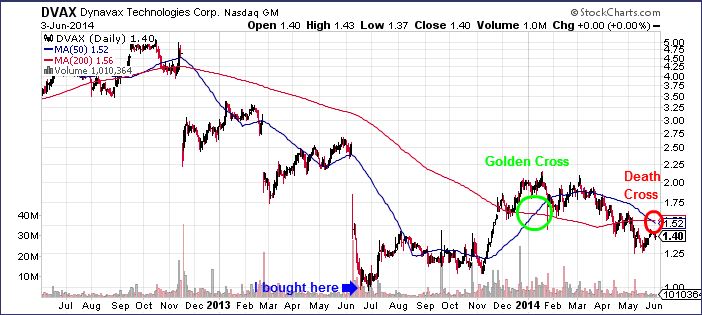A while back, I wrote an article about why I’m holding shares of Dynavax. Since I published that post about four months ago, DVAX is down more than 25%. Despite the drop in share price, I’m still up 40% on my trade, but I must admit that Dynavax shareholders haven’t had much fun lately.
I want to make two points about that chart before I move on. First, notice the death cross that happened in the past few days. I discussed the death cross in the MPEL chart last week. That’s not a great sign. Lots of technical analysts use crosses as buy and sell indicators, but they are far from a sure thing. In fact, look at the golden cross I noted on the DVAX chart above. If you had bought shares of DVAX when the golden cross happened and sold when the recent death cross happened, you would have bought at around $1.90 and sold at $1.45 for a 23% loss. Not the move of choice.
The other point I wanted to make about the DVAX chart is the point of timing. In the stock market, timing is everything. If you bought DVAX two months ago at $1.75, you’d be down about 20% right now. If you bought DVAX two years ago at $3.50, you’d be down 60% right now. I believe in the DVAX story the same as the person that bought at $1.75 and the person that bought at $3.50. We all own the same shares of DVAX stock. The only reason I’m up 40% is because of timing. Right now, I look like a genius because I bought DVAX at almost exactly its three-year low point. But six months from now if DVAX is trading at $0.50 and I missed my chance to sell my shares at a 100% gain, I will no longer look like a genius. I will look like a doofus. Good timing on your buys is always critical, but it’s only half of the equation because you always need good timing on your sells as well.
With Dynavax’s recent decision to undergo a reverse stock split, I admit I do have concerns about the company. If DVAX does in fact drop to $0.50, I will certainly feel like a doofus. But I’ll take a hit to my pride over a hit to my wallet any day. When I bought DVAX, I understood the high risk involved in buying a small-cap biotech stock with only a handful of drugs in its pipeline. Stocks like DVAX are high-risk/high-reward stocks. And there’s nothing wrong with having some risk in your portfolio. Often times it’s the riskier stocks that provide the highest gains if you have good timing on your trades. And I must admit, the risky, volatile stocks are often the most fun to watch when they take off like DVAX did when it shot from $1.00 to $2.00 in six months last year!
My rule of thumb with risk is the same rule of thumb I use with Krispy Kreme donuts: it’s fine in moderation. Having a portfolio filled with risky stocks is as ridiculous as sitting down and inhaling a dozed glazed donuts: it might be fun, but it’s also extremely dangerous over time. Sure it will suck if I end up losing money on DVAX, especially after I was up over 100% a few months ago. But DVAX currently represents about 2% of my portfolio, so even if it went to zero I would be far from financial ruin.
Diversifying risk levels in your portfolio is as important as diversifying the sectors you invest in. Compared to cash or bonds or CDs, stocks are all risky. Even Coke, McDonalds, and Walmart stocks are riskier than a CD. As it stands right now, about 31% of my portfolio I would consider to be relatively low-risk long-term stocks such as Apple and Wells Fargo. About 17% of my portfolio is higher-risk stocks like Dynavax and Bank of Ireland. About 20% of my portfolio is stocks that I frequently trade in and out of based on technical analysis (some of these stocks may be high-risk stocks, but since I typically use very tight stops on these technical trades, much of the risk is mitigated). And finally, 32% of my portfolio is currently cash, which is about as safe as it comes.
It’s also important to remember that I’m in my 30s, so I can afford a much higher risk level than someone who is approaching retirement. It would be terrible for me to lose all my money, but the reality is that I would have 30+ years to recover. As I discuss in my book, risk tolerance should be determined on a person-to-person basis, and that determination should include considerations such as age, financial situation, personality traits, and financial goals.
Want to learn how to determine your appropriate risk level? Or maybe you just want to look sophisticated in front of your coworkers when they ask you what you are reading on your Kindle, and you’d prefer to tell them “Oh, I’m just reading a book about stock market analysis,” rather than the usual “Oh, I’m just looking at pics of my ex-girlfriend on Facebook.” For these reasons and more, check out my book, Beating Wall Street with Common Sense. I don’t have a degree in finance; I have a degree in neuroscience. You don’t have to predict what stocks will do if you can predict what traders will do and be one step ahead of them. I made a 400% return in the stock market over five years using only basic principles of psychology and common sense. Beating Wall Street with Common Sense is now available on Amazon, and tradingcommonsense.com is always available on your local internet!


